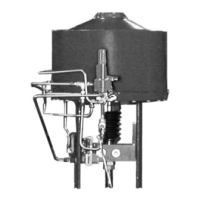Instruction Manual
D200319X012
377 Trip Valve
August 2012
12
When supply pressure falls below the trip point, the exhaust port opens venting supply pressure from the lower
diaphragm. This causes the upper ports of the plug assemblies to close and the lower ports to open. Because ports C
and F are plugged, no pressure change occurs on either side of the actuator piston and the piston is pressure‐locked in
position. No volume tank is necessary in this mode.
When supply pressure is restored, the plug assemblies move back into the normal operating position. Supply pressure
from the control device is applied to the actuator through ports A and B and ports D and E.
377U Trip Valve
Figure 9 illustrates trip valve operation in the fail‐up mode. The fail‐up mode of operation is similar to the fail‐down
mode of operation except that the connections to port C and F are reversed. When supply pressure falls below the trip
point, the top of the actuator cylinder vents, and volume tank pressure loads the bottom of the actuator cylinder. The
pressure imbalance created forces the actuator piston up.
Maintenance
Trip valve parts are subject to normal wear so the trip valve must be actuated periodically to determine if it is working
properly. If the trip valve does not work properly, use the following procedures to inspect and repair or replace parts as
necessary. The frequency of inspection and repair or replacement depends upon the severity of service conditions. Be
sure to note the location of all pressure connections to ensure proper trip valve installation upon reassembly, or use
the installation procedures in this instruction manual. All key numbers refer to figure 10 unless otherwise indicated.
WARNING
Avoid personal injury or property damage from sudden release of process pressure or bursting of parts. Before performing
any maintenance operations:
D Always wear protective clothing, gloves, and eyewear when performing any maintenance operations to avoid personal
injury.
D Do not remove the actuator from the valve while the valve is still pressurized.
D Disconnect any operating lines providing air pressure, electric power, or a control signal to the actuator. Be sure the
actuator cannot suddenly open or close the valve.
D Use bypass valves or completely shut off the process to isolate the valve from process pressure. Relieve process pressure
from both sides of the valve. Drain the process media from both sides of the valve.
D Vent the power actuator loading pressure and relieve any actuator spring precompression.
D Use lock‐out procedures to be sure that the above measures stay in effect while you work on the equipment.
D Check with your process or safety engineer for any additional measures that must be taken to protect against process
media.
Periodic Operational Check
WARNING
The following procedure requires taking the trip valve out of service. To avoid personal injury and property damage by
uncontrolled process medium, provide some temporary means of control of the process medium while the trip valve is out
of service.

